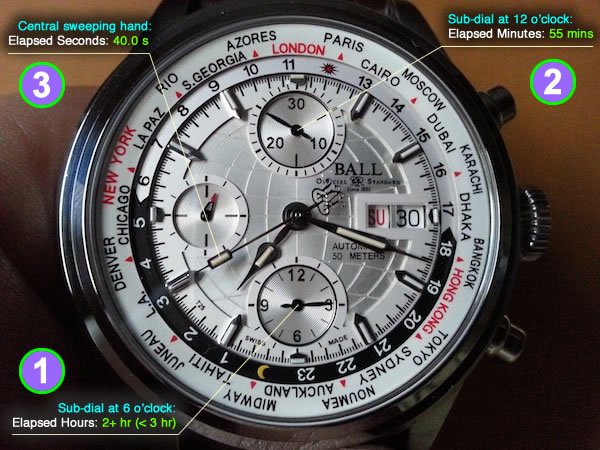Reading a chronograph watch can be as simple as 123, literally…or depending on the dial, as complicated as the square root of 32.
It is not difficult, but depending on the watch, it may take a while to figure out.
If it is a watch that you wear regularly, you would already be familiar with the display. In any case, I will be showing how the elapsed time can be read off the dials (and subdials) on some of the chronograph watches in my collection.
I’ll start with some photos and description in the captions.
On the Tag Heuer Kirium Quartz Chronograph…

The chronograph on the Tag Heuer Kirium is quite simple to read, with an accuracy to 0.1 of a second indicated on the sub-dial at 2 o’clock. The elapsed minute hand is tipped with an arrow head, to differentiate it from the central sweeping elapsed second hand. The elapsed chronograph time shown in the example above is 0 hour 4 minutes 47.8 seconds.
On the Maurice Lacroix Les Classiques Chronographe Automatique…

The chronograph on the Maurice Lacroix Les Classiques Chronographe Automatique is based on the common ETA/Valjoux 7750 which you will find on many chronograph watches.
If you’re buying or already own a chronograph watch, chances are it would look like this. The reading of elapsed time here is not quite as straightforward.
In the example above, first, read the elapsed hours on the sub-dial at 6 o’clock. As shown, it is greater than half an hour but less than one hour. This would help determine the elapsed minute on the sub-dial at 12 o’clock, hence 43 mins and not 13 mins. Elapsed seconds is read off the central sweeping hands, and with 4 subdivisions (or 3, depending on how you look at it) to an accuracy of 0.25 of a second, hence 47.5 seconds as shown here (note parallax error in photo above).
The subdial at 9 o’clock is the small second counter working in conjunction with the main central hour and minute hands in reading the time of day, and hence does not play a part in the reading of the chronograph.
On the Ball Trainmaster Worldtime Chronograph…

Likewise, on the Ball Trainmaster Worldtime Chronograph which uses the same Valjoux 7750 base movement, the elapsed hour subdial at 6 o’clock is first read as greater than 2.5 hours and less than 3 hours. This means that the elapsed minute subdial at 12 o’clock is on its second revolution at 55 minutes and not 25 minutes.
The elapsed seconds scale is similar with 4 subdivisions to an accuracy of 0.25 seconds, but the central sweeping hand falls squarely on the 40th second in our example above. The elapsed time on the chronograph here is hence 2 hours 55 minutes and 40.0 seconds.
As before, the time of the day’s small seconds subdial at 9 o’clock is ignored.
Uses for the Chronograph
– Mike Disher, WatchTime Magazine February 2014
Many people have asked me if there is really any practical use of the chronograph on the watch worn daily.
For most people (myself included), the chronograph serves more as an aesthetic decoration on an otherwise dull and boring watch dial.
Nevertheless, the watch chronograph does have its purpose beyond being merely a technical embellishment, and these are some of the ways I use them:
- Entering a paid carpark area and in the dark without looking at my watch, I start the chronograph upon taking the ticket at the entrance barrier. With knowledge of the grace period (usually 15 or 20 minutes, sometimes less), I will then keep track of the elapsed time since entry, and attempt to leave the carpark before the end of the grace period to avoid paying for parking, especially if it is only for a quick stopover.
- Bidding for an item on eBay, I will start the watch chronograph timer on the final minute, which allows me to keep track of the bidding end time based on the chronograph elapsed time. Hence, at the 50th second, I would have another 10 seconds before the bid time ends. This is to counter any false timer countdown on the computer screen due to slow connection or bad refresh rates. I normally place my final offer at the 52nd second on the chronograph, and often successfully secure the bidding item!
- In my course of work, I am sometimes required to take measurements of temperature and humidity of a room with a sling psychrometer. To obtain a good reading, I use the chronograph on the watch and ensure that the psychrometer swings about 2 to 3 turns per second. The readings of the wet and dry bulb thermometers to derive the relative humidity are taken at two 1-minute intervals.
- I don’t do this often, but if I’m preparing half-boiled egg, the chronograph on the watch would serve as a useful timer. I could use a dedicated egg timer or the digital one on my mobile phone, but the mechanical one on the watch just has greater appeal. That is, if you require this kind of accuracy. Otherwise, the minute hand on the watch is usually good enough.
Below are samples of good and reliable chronograph watches. Have fun keeping track of time to the second!
